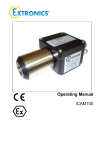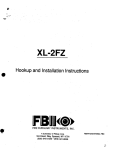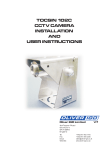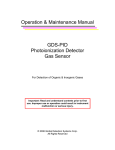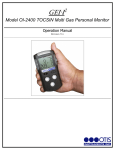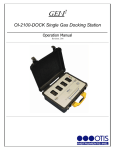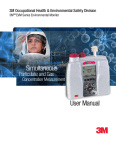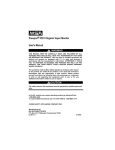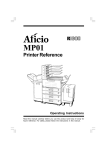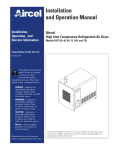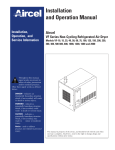Download TOCSIN 102 PhotoIonisation Gas Detector Manual
Transcript
TOCSIN 102PID INSTALLATION AND USER INSTRUCTIONS EEx d IIC T6 0518 II 2 D G Sira 02ATEX1271X OLIVER IGD Oliver IGD Limited 4a Pepper Road Stockport SK7 5BW England Tel: Fax: Email: Web Site: +44(0)161 483 1415 +44(0)161 484 2345 [email protected] www.oliver-igd.co.uk V1.0 OLIVER IGD Table of Contents Specification 3 CE Declaration 4 Installation 5 ATEX Junction Boxes and Sealing Requirements 5 ATEX Markings and Electrical Interface 420mA 6 Introduction to PID 7 VOC's 8 Lamp Types and Detection Methods 9 PID Detection Sensitivity 10 PID Correction Factor Tables 12 The PID Maintenence Lamp Life 23 Lamp Cleaning 23 Replacing the Electrode Stack 24 Accessories 25 OLIVER IGD PERFORMANCE Low Range Target gases Minimum detection level Linear range Overrange Sensitivity Full stabilisation time Warm up time Response time (t 90) VOCs with ionisation potentials < 10.6eV (ppb isobutylene) (ppm isobutylene)(5% deviation) (ppm isobutylene) (linear range) (mV / ppm Isobutylene) (minutes to 100ppb) (seconds) time to full operation (seconds) diffusion mode 5 50 50 > 20 20 5 ELECTRICAL Power consumption Supply voltage Output signal 0.9W typical (at 24V DC) 18 to 32VDC Linear 4-20mA Output for set range. RS232 Interface ENVIRONMENTAL Temperature range Temperature dependence Relative humidity range Humidity sensitvity -10ºC to +55ºC 0°C to 40°C: 95% to 100% of signal at 25°C -20°C: 125% of signal at 25°C 0 to 95%rh, non-condensing Near zero KEY SPECIFICATIONS Expected operating life Approval Onboard filter Lamp replacement Electrode stack Position sensitivity Weight 5 years (excluding replaceable lamp and electrode stack) SIRA02ATEX1271X EEXd 2C T6 2 II GD a To remove liquids and particulates User replaceable (10.6 eV) User replaceable None 550 grams (detector excluding any junction box) SIZE AND MOUNTING INFORMATION (OPTIONAL JUNCTION BOX/TOCSIN 903 SHOWN) 145.0 126.0 COVER SECURING SCREW M20 x 1.5 128.5 25.0 40.0 128.0 Ø7.0 Ø110 EXTERNAL EARTH 63.7 TOCSIN 102 PID DETECTOR SHOWN 3 High Range 100 300 6,000 > 0.6 20 5 <25 IGD OLIVER EC Declaration of Conformity Oliver IGD affirm under our sole responsibility that the following electrical equipment manufactured by us fulfills the requirements of the: ATEX Directive 94/9/EC, EMC directive 2004/108/EC LVD directive 2006/95/EC. Oliver Ref T102ECDEC Product Description Tocsin 102 2 or 3 wire 4-20mA Gas Detector Head or Camera Date of First Application JULY 2007 Approval to Type ISO9001:2000 Quality system and ATEX Quality Module ATEX Marking II 2 GD Ex d IIC T6 +55°C EC Type Certificate Notified Body Name, Number and Address Sira 02ATEX1271X Sira 0539 Rake Lane, Eccleston Chester. UK Manufactured By Oliver IGD Limited, 4a Pepper Road, Stockport, SK7 5BW England. Standards Applied BS EN 61000-4-6 2009 BS EN 61000-4-2 2009 BS EN 60079-1 2004 inc corr 1 BS EN 60079-0 2006 BS EN 61241-0 2006 BS EN 61241-1 Oliver IGD Limited operate an ISO9001:2000 Quality System which incorporates the requirements of the ATEX directive. Signed Andrew Collier. Managing Director 75 Years In Gas Detection PIONEERS 30 Years In Gas Analysis Registered in England No. 1044944 4 IGD OLIVER CUSTOMER SEALING AND EARTHING RESPONSABILITIES The Tocsin 102PID is designed for use in Zone 1 and Zone 2 hazardous areas and is ATEX certified. To maintain compliance it is imperative the installer of the equipment observes the following installation guidelines. Failure to do so could compromise the protection concept of the equipment. The Tocsin 102PID must be installed using a junction box which is suitable for the zone into which the equipment is being installed. Suitable junction boxes are available from Oliver IGD Limited. A typical example is indicated. Parallel glands and blanking plugs should have O Ring seals EXTERNAL EARTH TERMINAL or sealing washers to maintain IP66 rating use Atex rated glands and blanking plugs Taper glands and blanking plugs should use suitable thread sealant to maintain IP66 rating, typical LOCTITE 577 use Atex rated glands and blanking plugs On final assembly the cover screw must be locked in place. Use 2mm Allen Key Gas detectors are supplied with sealing washers. These must be fitted to meet approval requirements 5 IGD OLIVER TOCSIN 102PID 4-20mA 3 Wire VOC Gas Transmitter Fitting and Markings. Blue Signal Red +Ve Black -Ve Serial Programming Interface. DO NOT ACCESS IN A HAZARDOUS AREA Green Earth There are no user serviceable components inside the Tocsin 102. Do not connect to portable equipment Observe Marked Warnings DO NOT OPEN WHEN AN EXPLOSIVE ATMOSPHERE MAY BE PRESENT. Under no circumstances should the housing be opened in a potentially hazardous atmosphere. Oliver IGD Address OLIVER IGD Ltd 4a Pepper Rd, Stockport, England EEx d IIC T6 IP66 Rating 6W Max Sira 02ATEX1271X Serial Number 102PID-xxxxx-2002 0518 Environmental Rating Test Body Report Number Calibration should be undertaken at a maximum of six monthly intervals. Device Serial Number EU 'CE' Marking and ATEX Lab Number II 2 GD ATEX Markings With Explosive Protection Marking Explanation of Markings Flameproof Housing Concept Gas Group Maximum Housing Temperature Taking Into Account Maximum Ambient Temperature Maximum Rating Of Internal Circuitry Certificate Number EEx d IIC T6 Rating 4W Max Sira 02ATEX1271X IP66 Ingress Protection Rating 6-Complete Protection From Live Components Inside Housing, Dust Ingress Protection 6-Protection Against Conditions On Ships Decks II 2 GD Suitable For Use In Zone 1 & 2 Areas In Potentially Explosive Atmospheres Due To Gases, Vapours Mists or Dusts. Typical Control Card Connections 0V DC Fitting, Instructions 24V DC Allowable Operating Region R (Ohms) Sense 18 Blue Sig Serial Port Plug 200 Black -Ve Red +Ve 1000 250 Ohms Green Enclosure Earth 32 SUPPLY VOLTS Use Lock Nut Supplied Fit Fibre Washer Do not overtighten the 102 into the junction box housing DO NOT OPEN WHEN AN EXPLOSIVE ATMOSPHERE MAY BE PRESENT. OLIVER IGD Ltd 4a Pepper Rd, Stockport, England EEx d IIC T6 IP66 Rating 6W Max Sira 02ATEX1271X Serial Number 102-xxxxx-2002 0518 CO2 0-5% II 2 GD 6 Check Supply Voltage And Load Resistance With Card Manufacturers Instructions. Note The Tocsin 102 Must Be Earthed, If necessary fit a brass earthing tab washer between the locknut and housing to bond to. Ensure the junction box, cable and glands carry appropriate certification for the area in which they are fitted. Cable screens IGD OLIVER The PID Photo-Ionisation Detector The Tocsin 102 PID detector measures volatile organic compounds (VOC’s) in air by photo ionisation detection (PID), which is shown schematically below. Test gas (1) is presented to the membrane filter at the top of the photo ionisation cell and freely diffuses into and out of the underlying chamber formed by the filter, housing walls, and a UV lamp window. The lamp emits photons(shown by arrows) of high energy UV light, transmitted through the window. Photo ionisation occurs in the chamber when a photon is adsorbed by the molecule, generating two electrically charged ions, one positively charged, X+, and one negatively charged Y- (2a). An electric field, generated between the cathode and anode electrodes, attracts ions (2b). The resulting current, which is proportional to the concentration of the VOC, is measured and used to determine the gas concentration. The low range version of the Tocsin 102 PID (measuring at ppb levels) includes a third fence electrode (patented) to ensure that the amplified current does not include significant contributions due to other current sources such as water condensation on the chamber walls. Note that the Oliver IGD Tocsin 102 PID is available in high range and low range models. If supplied as a stand alone unit then a standard linear 4-20mA output is provided along with a diagnostic port. This can be used in conjunction with Oliver IGD configurator software for service diagnostics and maintenance. This software can be used to set lamp duty cycles to extend lamp life. as standard units will be shipped with a 50% duty cycle set at 10 seconds. note that the duty cycle function is disabled once gas is detected and for 10 minutes after returning to zero. For full details refer to the PID section of the configurator manual. A full range of splash guards, calibration adaptors, duct adaptors, samplers and service tools are available from Oliver IGD. In dirty environments always consider fitting splash guards to extend service intervals. Membrane Filter PID housing Test gas 1 Cathode Fence electrode 2 Anode Y Lamp window X 2a Photon Lamp body To cathode Y Lamp gas, e.g. krypton 2b - + X To anode What is a volatile organic compound (VOC)? A volatile organic compound, or VOC, is a carboncontaining chemical, which is significantly or completely vaporised at ambient temperatures. 7 OLIVER IGD What volatile organic compounds (VOC’s) is sensed by PID? Most VOC’s can be detected by PID. Notable exceptions are low molecular weight hydrocarbons. Each VOC has a characteristic threshold energy of light (photon energy) which, when directed at the VOC, causes it to fragment into ions. This is called the Ionisation Potential , or IP. VOC’s are ionised (and hence detected) if light of photon energy greater than the IP interacts with the gas sample. The peak photon energy generated in a detector depends on the PID lamp used: Xenon = 9.6 eV, Deuterium = 10.2 eV, Krypton = 10.6 eV or Argon = 11.7 eV. Hence, the use of an argon lamp leads to detection of the largest range of volatile compounds, while using a Xenon lamp can increase selectivity. Lamps of a particular type do not typically vary in spectral fingerprint, so relative responses to a particular gas, e.g. benzene, to a particular lamp, e.g. krypton, does not vary from lamp to lamp. However, the intensity of lamps does vary to some extent, leading to a difference in absolute response to the calibration gas. Sufficient volatility of a compound is also esse ntial for measurement by PID as with any other detector. A fairly large molecule such as alpha pinene, (a constituent of turpentine), saturates in air at about 5000 ppm at 20 oC; this is the maximum concentration at which the compound will usually be detected. Some compounds, for example, machine oils and agrochemicals - generate only a few ppm of vapour at ambient temperatures; it is more difficult to detect these compounds in air. Which lamp is best? The choice of lamp depends on target gases, selectivity requirements and lamp lifetime considerations. Where possible the krypton lamp is used for the high sensitivities it delivers. Xenon lamp (9.6 eV) Many aromatics and unsaturated VOC’s compounds c ontaining at least 6 carbon atoms (‘C6’) or more are detected. Sometimes it is an advantage to use the xenon lamp to ensure more selective detection of such compounds. Krypton lamp (10.6 eV) Some C2, and most C3, C4+ VOC’s are detected. Exceptions usually contain chlorine, fluorine or bromine. For guidance, you can expect the following to be detected with Krypton-PID: • • • • • • All hydrocarbons, whose chemical names end in the letters –ane, –ene or –yne, except methane, ethane, propane, and acetylene, and also except if the name includes ‘ chloro’, ‘fluoro’ or ‘bromo’: All alcohol’s, whose chemical names end in –ol, except methanol, or frequently if the name includes ‘chloro’, ‘fluoro’ or ‘bromo’ All aldehydes, whose names end in aldehyde, except formaldehyde, or sometimes if the name includes ‘chloro’, ‘fluoro’ or ‘bromo’ All ketones, whose chemical names end in –one, except rarely if the name includes ‘chloro’, ‘fluoro’ or ‘bromo’ All esters, whose names end in –ate, except rarely if the name includes ‘ chloro’, ‘fluoro’ or ‘bromo’ All amines, sulfides 8 OLIVER IGD Argon lamp (11.7 eV) All VOC’s detectable with the kryton lamp, plus acetylene, methanol, formaldehyde and about 80% of VOC’s whose chemical names include ‘ fluoro’, ‘chloro’ and ‘ bromo’. However, this lamp has a very short lifetime because the UV window is made from Lithium Fluoride, which is prone to degradation. What is a response factor? The sensitivity of PID varies according to the type of lamp used (krypton, argon or xenon) and the VOC detected. A response factor is a number, which relates the PID response to a particular VOC, to the PID response to the calibration gas, usually isobutylene. If the response of a PID to a particular VOC were eight times smaller than it is for the same concentration of isobutylene, then the response factor would be 8. Similarly, if the response factor for a particular VOC is 0.5, the PID response is twice that for isobutylene at the same concentration. Example: • • • • • A sensor is calibrated using isobutylene and found to have a sensitivity of 2-mV ppm -1. If the sensor is exposed to 100-ppm isobutylene the output will be 200 mV. Toluene is known to generate twice the response of isobutylene. If the sensor is exposed to 100-ppm toluene the output will be 400 mV. In order to correct the response it is multiplied by the response factor for toluene of 0.5. If response factors are programmed into an instrument, you are able to specify a volatile compound, and the instrument will internally compensate for the response factor corresponding to that volatile, and display and record the corrected volatile concentration.‘ . Are there other ways to measure VOC’s? PID's show excellent sensitivity, a large dynamic range and allow ppb-low ppm measurement of VOC’s in a background of higher inorganic gas concentrations. But there are other technologies to measure VOC’s: Flame Ionisation Detectors (FID) Very similar to PID’s, FID's are frequently used in laboratories for detecting VOC’s eluted from a gas chromatograph. FID’s like PID’s are not selective, indeed all organic compounds including methane are selected, and FID’s can be very sensitive and linear. But FID’s require a hydrogen source, are bulky and more expensive. FID’s are good in the lab or for fixed sites, but are not currently a viable alternative in portable VOC monitoring. Portable GC/MS This traditional laboratory analytical instrument is seeing its way into the field with mixed results. With micro machined silicon (MEMS), portable MS and portable GC may still become a real alternative, but the cost is prohibitive. Sinc e GC/MS can only cycle through a measurement, it is not a continuous monitor, but measures about once every few minutes. It does have the advantage of being selective - it is not a broad band analyser. Size, cost, need for a vacuum pump and maintenance requirements make this only an alternative when all else fails. 9 OLIVER IGD Thermal Desorption or Tedlar sampling bags For retrospective analysis of all VOC’s adsorbed in soil samples, other solids, liquids and gases, the ASTM recommends using sorbent tubes or Tedlar sampling bags. Samples are then sent to the lab for thermal desorption of the sorbent tubes and then analysis using GC/MS, traditionally. This is the best technique when surveying a spec ific problem, but clearly does not provide protection in real time. Also, these are averaged measurements, expensive and not point/timespecific. Electrochemical sensors You can measure many VOC’s with electrochem ical cells, with resolution from 10 to 200 ppb. These are low cost, low power, and compact sensors. Oliver IGD offers the ETO sensor for VOC applications. Both PID’s and electrochemical cells are broad band sensors, but with a different profile - PID’s will measure more VOC’s than the ETO, and with much greater sensitivity. If you wish to measure a VOC with electrochemical cells, then you should optimise the electrochemical sensor for the target VOC: each VOC will require a different ideal bias voltage for best sensitivity. Not an easy task. Electrochemical cells respond in about 25 seconds, vs. 3-4 seconds for PID’s. Metal Oxide Semiconductor sensors (MOS) Metal oxide sensors will also measure VOC’s; they are compact, low cost and similar power to PID’s. MOS sensors suffer from humidity sensitivity, non-linear response and long term drift. They also respond to inorganic gases, so you should not use them if you are trying to measure low concentrations of VOC’s where gases such as NO, NO2 or CO are present in higher concentrations. Unfortunately, it is all too easy to get false positive and false negatives when using MOS technology. If you want to use MOS, then request confirmation of long term stability, and humidity sensitivity. If you want high sensitivit y, particularly to VOC’s not measured by PID ( i.e. many CFC’s), but don’t care about accuracy and cross sensitivity, MOS sensors may provide a possible solution. Colorimetric (“Stain”) tubes Well-established technology for sampling for specific VOC’s, colorimetric tubes have been around for decades, supplied chiefly by Draeger or Ki ttegawa. They have the advantage of low one-off cost and some specificity, but the disadvantages include disposal of chemical waste (the disposable tubes often contain toxic chemicals), poor accuracy, human interpretation of the colour change, sampling problems and non-continuous measurements: they should not be used to protect, only to qualitatively sample. 10 OLIVER IGD Calibration Factors Oliver IGD PID's are calibrated using isobutylene, but the PID is a broadband VOC detector, with a sensitivity that differs for each VOC. If you know what VOC you are measuring, then the table below will allow you to calculate the concentration for your specific VOC. Remember, these are approximate values, so for best accuracy you should calibrate with the relevant VOC. The table includes six columns: 1 Gas/ VOC The most common name for the VOC. If you can not find the name of your VOC of concern, then email us at [email protected] and we will help. 2 CAS No. You can find the VOC using the CAS No.: ask your supplier. 3 Formula To assist in identifying the VOC. 4 Relative Response/ Correction Factor (CF) also called the Response Factor (RF). Multiply the displayed concentration by the Relative Response/ CF/ RF to calculate the actual concentration of the VOC. 5 Relative sensitivity (%) This is the inverse of the correction factor, specifying the percent response of the VOC, relative to isobutylene. If less than 100%, then the VOC is less responsive than isobutyl ene; if the relative sensitivity is greater than 100%, then the VOC is more re sponsive than isobutylene. Relative sensitivity (%) is specified the same way as cross-sensitivity for toxic gas sensors. 6 Minimum Detection Level (MDL) Also called Minimum Detectable Quantity (MDQ). Typical lowest concentration that can be detected. The PID-AH has greater sensitivity than the PID-A1, so the MDL for the PID-AH will be much less than the MDL for the PID-A1. The Relative Response/ CF/ RF is measured in dry air; high humidity will reduce this factor by 30% to 50%, so the CF/ RF should be increased in high humidities. VOC response The PID can not measure all VOC’s or gases. Two types of VOC’s are not measured: ZR: No response. The 10.6 eV lamp does not ionise the VOC and the VOC can not be measured. NV: The vapour pressure of the VOC at 20 °C is less than a few ppm, so this Semi-Volatile Organic Compound (SVOC) can not be measured. Occasionally you will be measuring a mixture of VOC’s. If the total concentration is within the linear range of your PID, then it is reasonable to assume that the concentrations are additive without interference between the different VOC’ s. Remember that if you are measuring a combination of VOC’s, then accurate measur ement of one of these VOC’s will be difficult; without careful data analysis, you will get only a CF averaged measurement *. Be cautious when reporting actual VOC concentration if you know that there may be several VOC’s present. Balance gas The relative response is measured in laborat ory air, with 20.9% oxygen, balance nitrogen. Some gases absorb UV light without causing any PID response ( e.g. methane, ethane). In ambient atmospheres where these gases are present, the measured concentration of target gas will be less than is actually present. Methane absorbs UV strongly, so for accurate measurements in methane containing atmospheres, calibrate with a calibration gas containing the expected methane concentration. 50% LE L methane reduces the reading by up to 50%. Gases such as nitrogen and helium do not absorb UV and do not affect the relative response. 11 OLIVER IGD The correction factor for a gas mix containing PID detectable gases A, B, C… with response factors RF (A), RF (B), RF(C), in relative proportions a: b: c… is given by: CF (mix) = 1 / [(a/CF (A) + b/CF (B) + c/CF(C)…] Accuracy of the Table This table is for indication only. Table accura cy is 1 to 2 digits only, so when calculating concentration for a specific VOC, specify to 1 or 2 digits only. For best accuracy, calibrate using the specific VOC. 12 IGD OLIVER Gas/ VOC Acetaldehyde Acetic Acid Acetic Anhydride Acetone Acetonitrile Acetylene Acrolein Acrylic Acid Acrylonitrile Allyl alcohol Allyl chloride Ammonia Amyl acetate, nAmyl alcohol Aniline Anisole Arsine Asphalt, petroleum fumes Benzaldehyde Benzene Benzenethiol Benzonitrile Benzyl alcohol Benzyl chloride Benzyl formate Biphenyl Bis(2,3-epoxypropyl) ether Boron trifluoride Bromine Bromine pentafluoride Bromobenzene Bromochloromethane Bromoethane Bromoethyl methyl ether, 2- Bromoform Bromopropane, 1Bromotrifluoromethane Butadiene Butadiene diepoxide, 1,3Butane, nButanol, 1Buten-3-ol, 1Butene, 1Butoxyethanol, 2Butyl acetate, nButyl acrylate, nButyl lactate Butyl mercaptan Butylamine, 2Butylamine, nCamphene Carbon dioxide CAS No. 75-07-0 64-17-7 108-24-7 67-64-1 75-05-8 74-86-2 107-02-8 79-10-7 107-13-1 107-18-6 107-05-1 7664-41-7 628-63-7 71-41-0 62-53-3 100-66-3 7784-42-1 8052-42-4 100-52-7 71-43-2 108-98-5 100-47-0 100-51-6 100-44-7 104-57-4 92-52-4 2238-07-5 7637 07 2 7726-95-6 7789-30-2 108-86-1 74-97-5 74-96-4 6482-24-2 75-25-2 106-94-5 75-63-8 106-99-0 1464-53-5 106-97-8 71-36-3 598-32-3 106-98-9 111-76-2 123-86-4 141-32-2 138-22-7 109-79-5 513-49-5 109-73-9 565-00-4 124-38-9 Formula Relative Relative response sensitivity (%) C2H4O C2H4O2 C4H6O3 C3H6O CH3CN C2H2 C3H4O C3H4O2 C3H3N C3H6O C3H5Cl H3N C7H14O2 C5H12O C6H7N C7H8O AsH3 4.9 36.2 4.0 0.7 ZR ZR 4.0 2.7 ZR 2.1 4.5 8.5 1.8 3.2 0.5 0.5 2.5 1.0 0.9 0.5 0.7 0.7 1.3 0.6 0.8 0.4 3.0 ZR 20.0 ZR 0.7 ZR 5.0 2.5 2.8 1.3 ZR 0.8 4.0 46.3 4.0 1.2 1.3 1.1 2.4 1.5 2.5 0.5 0.9 1.0 0.5 ZR C7H6O C6H6 C6H5SH C7H5N C7H8O C7H7Cl C8H8O2 C12H10 C6H10O3 BF3 Br2 BrF5 C6H5Br CH2ClBr C2H5Br C3H7OBr CHBr3 C3H7Br CF3Br C4H6 C4H6O2 C4H10 C4H10O C4H8O C4H8 C6H14O2 C6H12O2 C7H12O2 C7H14O3 C4H10S C4H11N C4H11N C10H16 CO2 13 Typical MDL Typical MDL Low Range (ppb) High Range (ppb) 21 3 25 140 25 180 20 5 480 3615 400 70 25 36 20 15 400 275 48 22 12 56 31 200 211 40 100 117 200 143 141 80 182 130 250 33 10 20 40 10 15 3 2 15 5 5 3 4 4 6 3 5 2 15 200 450 850 180 320 50 50 250 100 85 50 70 70 125 55 77 40 300 5 100 2000 143 4 70 20 40 36 77 25 15 15 7 500 250 280 130 120 25 2 25 87 77 91 41 67 40 185 111 100 222 4 20 230 20 6 7 6 10 8 15 3 5 5 2 80 400 4600 400 115 130 110 240 150 250 50 90 100 45 OLIVER Gas/ VOC Carbon disulfide Carbon monoxide Carbon tetrabromide Carbon tetrachloride Carbonyl sulphide Carvone, RChlorine Chlorine dioxide Chlorine trifluoride CAS No. 75-15-0 630-08-0 558-13-4 56-23-5 463-58-1 6485-40-1 7782-50-5 10049-04-4 7790-91-2 Chloro-1,1,1,2-tetrafluoroethane 2837-89-0 Chloro-1,1,1-trifluoroethane, 275-88-7 Chloro-1,1,2,2-tetrafluoroethane 354-25-6 Chloro-1,1,2-trifluoroethane, 1421-04-5 Chloro-1,1-difluoroethane, 175-68-3 Chloro-1,1-difluoroethane, 175-68-3 Chloro-1,1-difluoroethane, 2338-65-8 Chloro-1,2,2-trifluoroethane 431-07-2 Chloro-1,3-butadiene, 2126-99-8 Chloro-1-fluoroethane, 1- 1615-75-4 Chloro-2-fluoroethane, 1762-50-5 Chloroacetaldehyde 107-20-0 Chlorobenzene 108-90-7 Chlorodifluoromethane 75-45-6 Chloroethane 75-00-3 Chloroethanol 2107-07-3 Chloroethyl methyl ether, 2627-42-9 Chlorofluoromethane 593-70-4 Chloroform 67-66-3 Chloromethane 74-87-3 Chloropentafluoroethane 76-15-3 Chlorotoluene, o95-49-8 Chlorotoluene, p108-41-8 Chlorotrifluoroethylene 79-38-9 Chlorotrifluoromethane 75-72-9 Citral 5392-40-5 Citronellol 26489-01-0 Cresol, m108-39-4 Cresol, o95-48-7 Cresol, p106-44-5 Crotonaldehyde 4170-30-3 Cumene 98-82-8 Cyanamide 420-04-2 Cyanogen bromide 506-68-3 Cyanogen chloride 506-77-4 Cyclohexane 110-82-7 Cyclohexanol 108-93-0 Cyclohexanone 108-94-1 Cyclohexene 110-83-8 Cyclohexylamine 108-91-8 Cyclopentane 287-92-3 Decane, n124-18-5 Diacetone alcohol 123-42-2 Dibenzoyl peroxide 94-36-0 Formula IGD Relative Relative response sensitivity (%) CS2 1.4 71 CO ZR CBr4 3.0 33 CCl4 ZR COS ZR C10H14O 1.0 100 Cl2 ZR ClO2 1.0 100 ClF3 ZR C2HClF4 ZR C2H2ClF3 ZR C2HClF4 ZR C2H2ClF3 ZR C2H3ClF2 ZR C2H3ClF2 ZR C2H3ClF2 ZR C2H2ClF3 ZR C4H5Cl 3.2 30 C2H4ClF ZR C2H4ClF ZR C2H3OCl ZR C6H5Cl 0.5 220 CHClF2 ZR C2H5Cl ZR C2H5ClO 10.0 10 C3H7ClO 2.6 40 CH2ClF ZR CHCl3 ZR CH3Cl ZR C2ClF5 ZR C7H7Cl 0.5 220 C7H7Cl 0.5 200 C2ClF3 1.0 100 CClF3 ZR C10H16O 1.0 100 C10H20O 1.0 100 C7H8O 1.1 95 C7H8O 1.1 95 C7H8O 1.1 95 C4H6O 1.0 100 C9H12 0.6 170 CH2N2 ZR CNBr ZR CNCl ZR C6H12 1.3 77 C6H12O 2.9 34 C6H10O 1.1 91 C6H10 0.8 133 C6H13N 1.0 102 C5H10 4.0 25 C10H22 1.0 96 C6H12O2 0.8 125 C14H10O4 0.8 125 14 Typical MDL Typical MDL Low Range (ppb) High Range (ppb) 7 140 15 300 5 100 5 100 16 320 2 50 50 13 1000 250 2 3 5 50 50 100 5 5 5 5 5 5 3 100 100 105 105 105 100 60 7 15 6 5 5 20 5 5 5 130 300 110 75 100 400 100 80 80 IGD OLIVER Gas/ VOC CAS No. Formula Diborane 19287-45-7 B2H6 Dibromochloromethane 124-48-1 CHBr2Cl Dibromodifluoromethane 75-61-6 CF2Br2 Dibromoethane 1,2106-93-4 C2H4Br2 Dibromotetrafluoroethane 124-73-2 C2F4Br2 , 1,2Dibutyl hydrogen 107-66-4 HC8H18 phosphate PO4 Dichloro-1,1,1306-83-2 C2HCl2F3 trifluoroethane, 2,2Dichloro-1,11649-08-7 C2H2Cl2F2 difluoroethane, 1,2Dichloro-1,2,2354-23-4 C2HCl2F3 trifluoroethane, 1,2Dichloro-1,2631-06-1 C2H2Cl2F2 difluoroethane, 1,2Dichloro-1-fluoroethane, 1,1- 1717-00-6 C2H3Cl2F Dichloro-1-fluoroethane, 1,1- 1717-00-6 C2H3Cl2F Dichloro-1-fluoroethane, 1,2430-57-9 C2H3Cl2F Dichloro-1-propene, 2,378-88-6 C3H4Cl2 C2H2Cl2F2 Dichloro-2,2,79-35-6 difluoroethane, 1,1Dichloroacetylene 7572-29-4 C2Cl2 Dichlorobenzene o95-50-1 C6H4Cl2 Dichlorodifluoromethane 75-71-8 CCl2F2 Dichloroethane 1,2107-06-2 C2H4Cl2 Dichloroethane, 1,175-34-3 C2H4Cl2 Dichloroethene, 1,175-35-4 C2H2Cl2 Dichloroethene, cis-1,2156-59-2 C2H2Cl2 Dichloroethene, trans-1,2540-59-0 C2H2Cl2 Dichloroethylene 1,2540-59-0 C2H2Cl2 Dichlorofluoromethane 75-43-4 CHFCl2 Dichloromethane 75-09-2 CH2Cl2 Dichloropropane, 1,278-87-5 C3H6Cl2 Dichlorotetrafluoroethane, 1,1374-07-2 C2Cl2F4 Dichlorotetrafluoroethane, 1,276-14-2 C2Cl2F4 Dicyclopentadiene 77-73-6 C10H12 Diesel Fuel 68334-30-5 Diethyl ether 60-29-7 C4H10O Diethyl maleate 141-05-9 C8H12O4 Diethyl phthalate 84-66-2 C12H14O4 Diethyl sulphate 64-67-5 C4H10SO4 Diethyl sulphide 352-93-2 C4H10S Diethylamine 109-89-7 C4H11N Diethylaminoethanol, 2100-37-8 C6H15ON Diethylaminopropylamine, 3104-78-9 C7H18N2 Difluoroethane, 1,175-37-6 C2H4F2 Difluoroethane, 1,2624-72-6 C2H4F2 Difluoromethane 75-10-5 CH2F2 Dihydrogen selenide 7783 07 5 H2Se Dihydroxybenzene, 1,2 120-80-9 C6H6O2 Dihydroxybenzene, 1,3 108-46-3 C6H6O2 Diisobutylene 107-39-1 C8H16 Diisopropyl ether 108-20-3 C6H14O Diisopropylamine 108-18-9 C6H15N 15 Relative Relative response sensitivity (%) ZR 10.0 10 ZR 2.0 50 ZR 4.0 Typical MDL Typical MDL Low Range (ppb) High Range (ppb) 50 1000 10 200 25 20 400 70 7 140 20 200 25 3 500 50 105 125 143 133 5 4 4 4 100 80 70 75 3 200 3900 110 130 110 50 100 33 180 100 40 100 5 4 4 10 5 15 3 5 15 5 90 75 90 200 100 300 50 100 270 100 100 100 100 156 150 140 5 5 5 3 3 4 100 100 100 60 70 70 ZR ZR ZR ZR ZR ZR ZR 1.4 ZR 5.0 0.5 ZR ZR ZR 1.0 0.8 0.7 0.8 ZR 39.0 ZR ZR ZR 0.9 0.8 0.9 2.0 1.0 3.0 0.6 1.0 2.7 1.0 ZR ZR ZR 1.0 1.0 1.0 0.6 0.7 0.7 OLIVER Gas/ VOC Diketene Dimethoxymethane Dimethyl cyclohexane, 1,2- Dimethyl disulphide Dimethyl ether Dimethyl phthalate Dimethyl sulphate Dimethyl sulphide Dimethylacetamide N,NDimethylamine Dimethylaminoethanol Dimethylaniline, NNDimethylbutyl acetate Dimethylethylamine, NNDimethylformamide Dimethylheptan-4-one, 2,6- Dimethylhydrazine, 1,1Dinitrobenzene, mDinitrobenzene, oDinitrobenzene, pDinonyl phthalate Dioxane 1,2Dioxane 1,4Dipentene Diphenyl ether Disulphur decafluoride Disulphur dichloride Di-tert-butyl-p-cresol Divinylbenzene Dodecanol Enflurane Epichlorohydrin Epoxypropyl isopropyl ether, 2,3- Ethane Ethanol Ethanolamine Ethoxy-2-propanol, 1Ethoxyethanol, 2Ethoxyethyl acetate, 2Ethyl (S)-(-)-lactate Ethyl acetate Ethyl acrylate Ethyl amine Ethyl benzene Ethyl butyrate Ethyl chloroformate Ethyl cyanoacrylate Ethyl decanoate Ethyl formate Ethyl hexanoate Ethyl hexanol, 2Ethyl hexyl acrylate, 2Ethyl mercaptan CAS No. 674-82-8 109-87-5 583-57-3 624-92-0 115-10-6 131-11-3 77-78-1 75-18-3 127-19-5 124-40-3 108-01-0 121-69-7 108-84-9 598-56-1 68-12-2 108-83-8 57-14-7 99-65-0 528-29-0 100-25-4 84-76-4 123-91-1 138-86-3 101-84-8 5714-22-7 10025-67-9 2409-55-4 1321-74-0 112-53-8 13838-16-9 106-89-8 4016-14-2 74-84-0 64-17-5 141-43-5 1569-02-4 110-80-5 111-15-9 97-64-3 141-78-6 140-88-5 75-04-7 100-41-4 105-54-4 541-41-3 7085-85-0 110-38-3 109-94-4 123-66-0 105-76-7 103-11-7 75-08-1 Formula C4H4O2 C3H8O2 C8H16 C2H6S2 C2H6O C10H10O4 C2H6O4S C2H6S C4H9NO C2H7N C4H11NO C8H11N C8H16O2 C4H11N C3H7NO C9H18O C2H8N2 C6H4N2O4 C6H4N2O4 C6H4N2O4 C26H42O4 C4H8O2 C4H8O2 C10H16 C12H10O S2F10 S2Cl2 C11H16O C10H10 C12H26O C4H2F5ClO C3H5ClO C6H12O2 C2H6 C2H6O C2H7NO C5H10O2 C4H10O2 C6H12O3 C5H10O3 C4H8O2 C5H8O2 C2H7N C8H10 C6H12O2 C3H5O2Cl C6H7O2N C12H24O2 C3H6O2 C8H16O2 C8H18O C11H20O2 C2H6S 16 IGD Relative Relative response sensitivity (%) 2.2 45 1.4 71 1.1 95 0.2 435 1.3 80 1.0 100 ZR 0.5 200 1.3 75 1.4 70 1.5 70 0.6 167 1.6 60 0.8 125 0.9 110 0.8 125 1.0 100 3.0 33 ZR 5.0 20 1.0 100 1.5 67 1.5 67 0.9 110 0.8 125 ZR 3.0 33 1.0 100 0.4 250 0.9 110 ZR 8.0 15 1.1 90 ZR 8.7 10 3.0 33 2.0 50 29.8 3 3.0 33 3.0 33 3.6 28 2.0 50 1.0 100 0.5 185 1.0 105 80 1 1.5 67 1.8 56 30 3 2.6 38 1.5 67 1.0 100 0.7 145 Typical MDL Typical MDL Low Range (ppb) High Range (ppb) 11 7 5 1 7 5 220 140 105 23 130 100 3 7 7 8 3 8 4 5 4 5 15 50 130 140 150 60 160 80 90 80 100 300 25 5 8 8 5 4 500 100 150 150 90 80 15 5 2 5 300 100 40 90 40 5 800 110 45 15 10 150 15 15 20 10 5 3 5 400 8 10 150 15 8 5 3 870 300 200 3000 300 300 360 200 100 50 100 8300 150 180 3000 260 150 100 70 IGD OLIVER Gas/ VOC Ethyl octanoate Ethylene Ethylene dinitrate Ethylene glycol Ethylene oxide Ferrocene Fluorine Fluoroethane Fluoromethane Formaldehyde Formamide Formic acid Furfural Furfuryl alcohol Gasoline vapors Gasoline vapors Gasoline vapors 92 octane Germane Glutaraldehyde Halothane Helium Heptan-2-one Heptan-3-one Heptane nHexachloroethane Hexafluoroethane Hexamethyldisilazane, 1,1,1,3,3,3-. Hexamethyldisiloxane. Hexan-2-one Hexane nHexene, 1Hydrazine Hydrazoic acid Hydrogen Hydrogen bromide Hydrogen chloride Hydrogen cyanide Hydrogen fluoride Hydrogen peroxide Hydrogen sulfide Hydroquinone Hydroxypropyl acrylate 2- Iminodi(ethylamine) 2,2Iminodiethanol 2,2'Indene Iodine Iodoform Iodomethane Isoamyl acetate Isobutane Isobutanol Isobutyl acetate CAS No. 106-32-1 74-85-1 628-96-6 107-21-1 75-21-8 102-54-5 7782-41-4 353-33-6 593-53-3 50-00-0 75-12-7 64-18-6 98-01-1 98-00-0 8006-61-9 8006-61-9 8006-61-9 7782-65-2 111-30-8 151-67-7 110-43-0 106-35-4 142-82-5 67-72-1 76-16-4 999-97-3 107-46-0 591-78-6 110-54-3 592-41-6 302-01-2 7782-79-8 1333-74-0 10035-10-6 7647-01-0 74-90-8 7664-39-3 7722-84-1 7783-06-4 123-31-9 999-61-1 111-40-0 111-42-2 95-13-6 7553-56-2 75-47-8 74-88-4 123-92-2 75-28-5 78-83-1 110-19-0 Formula Relative Relative response sensitivity (%) C10H20O2 2.3 40 C2H4 8.0 13 C2H4O6N2 ZR C2H6O2 20.0 5 C2H4O 15.0 7 C10H10Fe 0.8 125 F2 ZR C2H5F ZR CH3F ZR CH2O ZR CH3ON 2.0 50 CH2O2 ZR C5H4O2 1.4 70 C5H6O2 2.0 50 1.1 95 0.8 125 0.8 125 GeH4 10.0 10 C5H8O2 0.9 111 CF3CHBrCl ZR He ZR C7H14O 0.7 140 C7H14O 0.8 133 C7H16 2.1 50 C2Cl6 ZR C2F6 ZR C6H19NSi2 1.0 100 C6H18OSi2 C6H12O C6H14 C6H12 H4N2 HN3 H2 HBr HCl HCN HF H2O2 H2S C6H6O2 C6H10O3 C4H13N3 C4H11NO2 C9H8 I2 CHI3 CH3I C7H14O2 C4H10 C4H10O C6H12O2 17 0.3 0.8 4.2 0.9 3.0 ZR ZR ZR ZR ZR ZR 4.0 4.0 0.8 1.5 0.9 1.6 0.5 0.2 1.5 0.4 1.6 8.0 3.5 2.3 Typical MDL Typical MDL Low Range (ppb) High Range (ppb) 12 40 230 800 100 75 4 2000 1500 80 10 200 7 10 5 4 4 50 5 140 200 105 80 80 1000 90 4 4 10 70 75 200 5 100 350 125 25 110 33 1 4 20 5 15 30 80 420 90 300 25 25 125 67 110 60 220 667 67 250 60 15 30 45 20 20 4 8 5 8 2 1 8 2 8 40 20 10 400 400 80 150 90 160 50 15 150 40 160 800 350 230 IGD OLIVER Gas/ VOC Isobutyl acrylate Isobutylene Isobutyraldehyde Isocyanates, all Isodecanol Isoflurane Isononanol Isooctane Isooctanol Isopentane Isophorone Isoprene Isopropanol Isopropyl acetate Isopropyl chloroformate Jet Fuel JP-4 Jet Fuel JP-5 Jet Fuel JP-8 Kerosene Ketene Liquefied petroleum gas Maleic anhydride Mercaptoacetic acid Mercury Mercury alkyls Mesitylene Methacrylic acid Methacrylonitrile Methane Methanol Methoxyethanol, 2Methoxyethoxyethanol, 2Methoxymethylethoxy-2propanol Methoxypropan-2-ol Methoxypropyl acetate Methyl acetate Methyl acrylate Methyl bromide Methyl cyanoacrylate Methyl ethyl ketone Methyl ethyl ketone peroxides Methyl formate Methyl isobutyl ketone Methyl isocyanate Methyl isothiocyanate Methyl mercaptan Methyl methacrylate Methyl propyl ketone Methyl salicylate Methyl sulphide Methyl t-butyl ether Methyl-2-propen-1-ol, 2- CAS No. Formula 106-63-8 115-11-7 78-84-2 C7H12O2 C4H8 C4H8O 25339-17-7 26675-46-7 2452-97-9 565-75-3 26952-21-6 78-78-4 78-59-1 78-79-5 67-63-0 108-21-4 108-23-6 C10H22O C3H2ClF5O C9H20O C8H18 C8H18O C5H12 C9H14O C5H8 C3H8O C5H10O2 C4H7O2Cl 8008-20-6 463-51-4 68476-85-7 108-31-6 68-11-1 7439-97-6 C4H2O3 C2H4O2S Hg 108-67-8 79-41-4 126-98-7 74-82-8 67-56-1 109-86-4 111-77-3 34590-94-8 C9H12 C4H6O2 C4H5N CH4 CH4O C3H8O2 C5H12O3 C7H16O3 C2H2O 107-98-2 C4H10O2 108-65-6 C6H12O3 79-20-9 C3H6O2 96-33-3 C4H6O2 74-83-9 CH3Br 137-05-3 C5H5O2N 78-93-3 C4H8O 1338-23-4 C8H18O2 107-31-3 C2H4O2 108-10-1 C6H12O 624-83-9 C2H3NO 556-61-6 C2H3NS 74-93-1 CH4S 80-62-6 C5H8O2 107-87-9 C5H10O 119-36-8 C8H8O3 75-18-3 C2H6S 1634-04-4 C5H12O 51-42-8 C4H8O 18 Relative Relative response sensitivity (%) 1.3 80 1.0 100 1.2 80 NV 0.9 110 ZR 1.5 67 1.1 90 1.7 60 6.0 20 0.8 133 0.7 140 4.4 20 2.2 50 1.6 60 0.8 133 0.7 150 0.7 150 0.8 120 3.0 33 ZR 2.0 50 1.0 100 NV NV 0.3 300 2.3 40 5.0 20 ZR 200 1 2.7 40 1.4 70 1.3 80 3.0 1.2 5.2 3.4 1.9 5.0 0.8 0.8 ZR 0.8 ZR 0.6 0.7 1.6 0.8 1.2 0.5 0.8 1.1 Typical MDL Typical MDL Low Range (ppb) High Range (ppb) 7 5 6 130 100 120 5 90 8 5 9 30 4 3 22 10 8 4 3 3 4 15 150 100 170 600 75 70 440 220 160 75 60 60 90 300 10 5 200 100 2 12 25 30 230 500 1000 15 7 7 20000 270 140 130 33 80 20 30 50 20 130 125 15 6 25 17 10 25 4 4 300 120 500 340 190 500 80 80 125 4 80 167 140 60 130 80 200 125 90 3 4 8 4 6 3 4 5 60 70 160 80 120 50 80 100 IGD OLIVER Gas/ VOC Methyl-2-pyrrolidinone, NMethyl-4,6-dinitrophenol, 2Methyl-5-hepten-2-one, 6- Methylamine Methylbutan-1-ol, 3Methylcyclohexane Methylcyclohexanol, 4Methylcyclohexanone 2Methylheptan-3-one, 5Methylhexan-2-one, 5Methylhydrazine Methyl-N-2,4, 6tetranitroaniline, NMethylpent-3-en-2-one, 4- Methylpentan-2-ol, 4Methylpentane-2,4-diol, 2- Methylpropan-2-ol, 2Methylstyrene Mineral oil Mineral spirits Naphthalene Nitric oxide Nitroaniline 4Nitrobenzene Nitroethane Nitrogen dioxide Nitrogen trichloride Nitrogen trifluoride Nitromethane Nitropropane, 1Nitropropane, 2Nitrous oxide Nonane, nNorbornadiene, 2,5Octachloronaphthalene Octane, nOctene, 1Oxalic acid Oxalonitrile Oxydiethanol 2,2Oxygen Ozone Paraffin wax, fume Paraffins, normal Pentacarbonyl iron Pentachloroethane Pentachlorofluoroethane Pentafluoroethane Pentan-2-one Pentan-3-one Pentandione, 2,4Pentane, nPeracetic acid CAS No. 872-50-4 534-52-1 110-93-0 74-89-5 123-51-3 108-87-2 589-91-3 583-60-8 541-85-5 110-12-3 60-34-4 479-45-8 141-79-7 108-11-2 107-41-5 75-65-0 25013-15-4 8042-47-5 64475-85-0 91-20-3 10102-43-9 100-01-6 98-95-3 79-24-3 10102-44-0 10025-85-1 7783-54-2 75-52-5 108-03-2 79-46-9 10024-97-2 111-84-2 121-46-0 2234-13-1 111-65-9 111-66-0 144-62-7 460-19-5 111-46-6 Formula Relative Relative response sensitivity (%) C5H9NO 0.9 110 C7H6N2O5 3.0 33 C8H14O 0.8 125 CH5N 1.4 70 C5H12O 3.4 30 C7H14 1.1 90 C7H14O 2.4 40 C7H12O 1.0 100 C8H16O 0.8 133 C7H14O 0.8 133 CH6N2 1.3 80 C7H5N5O8 3.0 33 C6H10O C6H14O C6H14O2 C4H10O C9H10 C10H8 NO C6H6N2O2 C6H5NO2 C2H5NO2 NO2 NCl3 NF3 CH3NO2 C3H7NO2 C3H7NO2 N2O C9H20 C7H8 C10Cl8 C8H18 C8H16 C2H2O4 C2N2 C4H10O3 O2 10028-15-6 O3 8002-74-2 64771-72-8 13463-40-6 FeC5O5 76-01-7 C2HCl5 354-56-3 C2Cl5F 354-33-6 C2HF5 107-87-9 C5H10O 96-22-0 C5H10O 123-54-6 C5H8O2 109-66-0 C5H12 79-21-0 C2H4O3 19 0.7 2.8 4.0 3.5 0.5 0.8 0.8 0.4 8.0 0.8 1.7 ZR 10.0 1.0 ZR ZR ZR ZR ZR 1.3 0.6 1.0 1.6 0.7 ZR ZR 4.0 ZR ZR 1.0 1.0 1.0 ZR ZR ZR 0.8 0.8 0.8 7.9 2.0 Typical MDL Typical MDL Low Range (ppb) High Range (ppb) 5 15 4 7 17 6 12 5 4 4 7 15 90 300 80 140 340 110 240 100 75 75 130 300 140 40 25 30 200 125 125 230 15 125 60 4 14 20 18 3 4 4 2 40 4 10 70 280 400 350 50 80 80 45 800 80 170 10 100 50 5 1000 100 80 167 100 60 140 6 3 5 8 3 130 60 100 160 70 25 20 400 100 105 100 5 5 5 100 100 100 125 125 133 15 50 4 4 4 40 10 80 80 75 800 200 IGD OLIVER Gas/ VOC Perchloryl fluoride Perfluoropropane Petroleum ether Phenol Phenyl propene, 2Phenyl-2,3-epoxypropyl ether Phenylenediamine, pPhosgene Phosphine Picoline, 3Pinene, alpha Pinene, beta Piperidine Piperylene Prop-2-yn-1-ol Propan-1-ol Propane Propane-1,2-diol, total Propene Propionaldehyde Propionic acid Propyl acetate, nPropylene dinitrate Propylene oxide Propyleneimine Pyridine Pyridylamine 2Silane Sodium fluoroacetate Styrene Sulphur dioxide Sulphur hexafluoride Sulphur tetrafluoride Sulphuric acid Sulphuryl fluoride Terphenyls Terpinolene Tert-butanol Tetrabromoethane, 1,1,2,2- Tetracarbonylnickel Tetrachloro-1,2difluoroethane, 1,1,2,2Tetrachloro-1fluoroethane, 1,1,2,2Tetrachloro-2,2difluoroethane, 1,1,1,2Tetrachloro-2fluoroethane, 1,1,1,2Tetrachloroethane, 1,1,1,2Tetrachloroethane, 1,1,2,2- Tetrachloroethylene Tetrachloronaphthalenes, all isomers Tetraethyl orthosilicate Tetraethyllead CAS No. Formula Relative Relative response sensitivity (%) 7616-94-6 Cl03F ZR 76-19-7 C3F8 ZR 0.9 110 108-95-2 C6H6O 1.2 85 98-83-9 C9H10 0.4 230 122-60-1 C9H10O2 0.8 125 106-50-3 C6H8N2 0.6 167 75-44-5 COCl2 ZR 7803-51-2 PH3 2.0 50 108-99-6 C6H7N 0.9 110 80-56-8 C10H16 0.3 315 127-91-3 C10H16 0.3 315 110-89-4 C5H11N 0.9 110 504-60-9 C5H8 0.7 150 107-19-7 C3H4O 1.3 80 71-23-8 C3H8O 4.8 20 74-98-6 C3H8 ZR 57-55-6 C3H8O2 10.0 10 115-07-1 C3H6 1.4 70 123-38-6 C3H6O 1.7 60 79-09-4 C3H6O2 8.0 15 109-60-4 C5H10O2 2.5 40 6423-43-4 C3H6N2O6 ZR 75-56-9 C3H6O 7.0 15 75-55-8 C3H7N 1.3 80 110-86-1 C5H5N 0.8 133 504-29-0 C5H6N2 0.8 125 7803-62-5 SiH4 ZR C2H2O2FNa 62-74-8 ZR 100-42-5 C8H8 0.4 230 7446-09-5 SO2 ZR 2551-62-4 SF6 ZR 7783-60-0 SF4 ZR 7664-93-9 H2SO4 ZR 2699-79-8 SO2F2 ZR C18H14 0.6 167 586-62-9 C10H16 0.5 210 75-65-0 C4H10O 2.6 40 79-27-6 C2H2Br4 2.0 50 13463-39-3 NiC4O4 1.0 100 76-12-0 C2Cl4F2 ZR 354-14-3 C2HCl4F ZR 76-11-9 C2Cl4F2 ZR 354-11-0 C2HCl4F ZR 630-20-6 79-34-5 127-18-4 20020-02-4 C2H2Cl4 C2H2Cl4 C2Cl4 C10H4Cl4 ZR ZR 0.7 1.0 78-10-4 78-00-2 C8H20O4Si 2.0 ZR C8H20Pb 20 Typical MDL Typical MDL Low Range (ppb) High Range (ppb) 5 6 2 4 3 90 120 45 80 60 10 5 2 2 5 3 7 25 200 90 30 30 90 67 130 480 50 7 8 40 13 1000 140 169 800 250 35 7 4 4 700 130 75 80 2 50 3 2 15 10 5 60 50 260 200 100 140 100 4 5 70 100 50 10 200 IGD OLIVER Gas/ VOC Tetrafluoroethane, 1,1,1,2Tetrafluoroethane, 1,1,2,2- Tetrafluoroethylene Tetrafluoromethane Tetrahydrofuran Tetramethyl orthosilicate Tetramethyl succinonitrile Therminol Thionyl chloride Toluene Toluene-2,4-diisocyanate Toluenesulphonyl chloride, pToluidine, oTributyl phosphate Tributylamine Trichloro-1,1difluoroethane, 1,2,2Trichloro-1,2difluoroethane, 1,1,2Trichloro-2,2difluoroethane, 1,1,1Trichloro-2-fluoroethane, 1,1,2- Trichlorobenzene 1,2,4Trichloroethane, 1,1,1Trichloroethane, 1,1,2Trichloroethylene Trichlorofluoromethane Trichloronitromethane Trichlorophenoxyacetic acid, 2,4,5Trichloropropane 1,2,3Trichlorotrifluoroethane, 1,1,1Trichlorotrifluoroethane, 1,1,2- Triethylamine Trifluoroethane, 1,1,1Trifluoroethane, 1,1,2Trifluoroethanol, 2,2,2Trifluoromethane Trimethylamine Trimethylbenzene mixtures Trimethylbenzene, 1,3,5Trinitrotoluene 2,4,6Turpentine TVOC Undecane, nVinyl acetate Vinyl bromide Vinyl chloride Vinyl-2-pyrrolidinone, 1Xylene mixed isomers CAS No. Formula Relative Relative response sensitivity (%) 811-97-2 C2H2F4 ZR 359-35-3 C2H2F4 ZR 116-14-3 C2F4 1.0 100 75-73-0 CF4 ZR 109-99-9 C4H8O 1.6 65 681-84-5 C4H12O4Si ZR 3333-52-6 C8H12N2 1.0 100 1.0 100 7719-09-7 SOCl2 ZR 108-88-3 C7H8 0.5 200 584-84-9 C9H6N2O2 1.6 60 98-59-9 C7H7SO2 3.0 33 Cl 95-53-4 C7H9N 0.5 200 126-73-8 C12H27O4P 5.0 20 102-82-9 C12H27N 1.0 100 354-21-2 C2HCl3F2 ZR 354-15-4 C2HCl3F2 ZR 354-12-1 C2HCl3F2 ZR 359-28-4 120-82-1 71-55-6 79-00-5 79-01-6 75-69-4 76-06-2 93-76-5 C2H2Cl3F C6H3Cl3 C2H3Cl3 C2H3Cl3 C2HCl3 CCl3F CCl3NO2 C8H5O3Cl 3 96-18-4 C3H5Cl3 354-58-5 C2Cl3F3 76-13-1 C2Cl3F3 121-44-8 C6H15N 420-46-2 C2H3F3 430-66-0 C2H3F3 75-89-8 C2H3F3O 75-46-7 CHF3 53-50-3 C3H9N C9H12 108-67-8 C9H12 118-96-7 C7H5N3O6 8006-64-2 C10H16 ZR 0.6 ZR ZR 0.7 ZR ZR 1.0 1120-21-4 C11H24 108-05-2 C4H6O2 593-60-2 C2H3Br 75-01-4 C2H3Cl 88-12-0 C6H9NO 1330-20-7 C8H10 ZR ZR ZR 0.9 ZR ZR ZR ZR 0.5 0.3 0.3 ZR 0.6 1.0 0.9 1.1 1.0 2.1 0.9 0.4 21 Typical MDL Typical MDL Low Range (ppb) High Range (ppb) 5 100 8 150 5 5 100 100 3 8 15 50 160 300 3 25 5 50 500 100 180 3 50 150 3 65 100 5 100 110 5 90 200 300 300 3 2 2 50 35 35 167 100 110 90 100 50 110 230 3 5 5 6 5 10 5 2 60 100 100 110 100 200 90 40 OLIVER Gas/ VOC Xylene, mXylene, oXylene, pXylidine, all CAS No. 108-38-3 95-47-6 106-42-3 1300-73-8 Formula C8H10 C8H10 C8H10 C8H11N 22 IGD Relative Relative response sensitivity (%) 0.4 230 0.6 167 0.6 180 0.7 140 Typical MDL Typical MDL Low Range (ppb) High Range (ppb) 2 3 3 4 50 60 50 70 OLIVER IGD Maintenence The electronics in the PID detector element and Tocsin 102PID are not accessible, being designed to be maintenance-free. Periodic sensor maintenance is required for the electrode stack and lamp. When does my PID require maintenance? Your PID lamp will need cleaning from time to time. How often? This depends on the environment you are measuring. If you are measuring indoor air quality with the low range, where the VOC concentrations are low and there are few particulates, then a monthly or even less frequent calibration may be adequate. However, if you are measuring high VOC concentrations with the highrange and particulates are present in high concentrations, then check calibration frequently and when the PID has lost sensitivity, change the stack as explained below. You can tell when the PID needs cleaning: • If the baseline is climbing after you zero the PID, then the electrode stack needs replacing. • If the PID becomes sensitive to humidity, then the electrode stack needs replacing. • If the baseline is unstable or shifts when you move the PID, then the electrode stack needs replacing. • If sensitivity has dropped too much (note the change required when checking calibration), then the lamp needs cleaning. When do I clean the PID lamp? Cleaning of the PID lamp is recommended as a first action when presented with a PID that needs cleaning. Use the procedure described below. It is recommended that a cell be recalibrated after cleaning a lamp, especially if the cell has been used for a few months since the sensor was last used. When do I replace the PID electrode stack? The PID electrode stack can last the lifetime of the PID if used in clean environments, or may only last a month if used in heavily contaminated sites. The electrode stack is a disposable item, so always hold a spare electrode stack if you are working in a dirty environment. If the cell shows signs of contamination after the lamp window has been cleaned, or is known to have been subjected to severe contamination, then it should be replaced. Instructions for replacing the electrode stack are below. It is recommended that the PID be recalibrated after replacing the electrode stack. 23 OLIVER IGD When do I replace the PID lamp? A PID lamp will last a long time, typically a few thousand hours. Lamps are warranted for six months; replacement bulbs are available and are not expensive to replace. The sensitivity of the PID is approximately in direct proportion to the lamp light intensity, so as the bulb ages and loses intensity; the response to a particular, low gas concentration becomes noisier. Note the PC configurator software allows for lamp duty cycles to extend lamp life, this software can also be used for calibration and diagnostics Removing the electrode stack and lamp (with unit powered down) Always use the Electrode Stack Removal Tool; any other tools may damage your PID and invalidate your warranty a. Gently remove the sensor from equipment. b. Place the PID, pellet side down, onto a clean surface. c. Locate electrode stack removal tool into the two slots on the sides of the PID and squeeze together until electrode stack and lamp are released. d. Lift carefully the PID body away from the pellet and lamp. e. Occasionally the lamp may be temporarily lodged in the cell and will need to be freed carefully with tweezers. f. Occasionally the small spring behind the lamp will come out when the lamp is removed from the sensor. Simply replace it into the sensor house. Cleaning the PID Lamp Inspection of the lamp may reveal a layer of contamination on the detection window that presents itself as a 'blue hue.' To check for contamination, hold the lamp in front of a light source and look across the window surface Only clean the lamp using our recommended lamp cleaning kit and detailed instructions. To avoid contaminating the sensor and affecting accuracy, do not touch the lamp window with bare fingers. You may touch the body of the lamp with clean fingers. PID lamp cleaning kit PID-CK The vial of cleaning compound contains alumina (CAS Number 1344-28-1) as a very fine powder. A full material safety data sheet MSDS is available on request Key safety issues are identified below: Hazard identification: May cause irritation of respiratory tract and eyes. Storage: • Keep container closed to prevent water adsorption and contamination. Handling: • • • • Do not breathe in the powder. Avoid contact with skin, eyes and clothing Wear suitable protective clothing Follow industrial hygiene practices: Wash face and hands thoroughly with soap and water after use and before eating, drinking, smoking or applying cosmetics. The powder carries a TVL(TWA) limit of 10 mg/m 3 24 OLIVER IGD Use of PID lamp cleaning kit 5981601 1. Open the container of alumina polishing compound. With a clean cotton bud, collect a small amount of the powder. 2. Use this cotton bud to polish the PID lamp window. Use a circular action, applying light pressure to clean the lamp window. Do not touch the lamp window with fingers. 3. Continue polishing until an audible “squeaking” is made by the cotton bud moving over the window surface. (usually within 15 seconds) 4. Remove the residual powder from the lamp window with a clean cotton bud. Care must be taken not to touch the tips of cotton buds that are to be used to clean the lamps as this may contaminate them with finger oil. 5. Ensure the lamp is completely dry and any visible signs of contamination are removed before refitting. Discarding the PID electrode stack Discard the contaminated electrode stack. The electrode stack does not have any toxic components, but if it has been contaminated by toxic materials, then show due care when disposing. Re-fitting the PID electrode stack and lamp Warning! Never refit a damaged lamp 1. 2. 3. 4. Place the lamp inside the O-ring seal in the pellet as illustrated. Twisting the lamp slightly during insertion will help to ensure the lamp window is snug against the pellet’s front electrode. The lamp should be freely supported by the O-ring. Continuing to hold the pellet between forefinger and thumb, carefully insert the lamp into recess in the sensor ensuring that the lamp remains in position. Press the pellet firmly, to ensure that the pellet wing clips are engaged, and the top faces of the pellet and sensor house are flush. Refit the sensor into the sensing equipment. Re-calibrate the gas detector in accordance with manufacturer’s instructions. Ordering spare components If you need spare components, then quote the order code below: 10.6eV lamp 5921401 Electrode stack 5921901 Electrode stack removal tool 5981801 Lamp cleaning kit 5981601 Lamp spring 5981701 25 IGD OLIVER Accessories and Complementary Products 145.0 126.0 COVERSECURINGSCREW M20x1.5 128.5 25.0 EEXd Junction Boxes Ref 5045802 40.0 Tocsin 903 Single Channel EEXd Controller with Display. Refer to seperate data sheet for full option list and part numbers. 128.0 Ø7.0 Basic unit with 4-20mA Output Options for: Relay Alarm Outputs Addressable Interface HART Interface Ø110 EXTERNALEARTH 40.0 GASDETECTOR Pitot Duct Adaptor P/N5139002 Dynamic Duct Adaptor P/N5999201 Type 4 Duct Adaptor P/N5133701 Type 3 Duct Adaptor P/N5133801 Splash/Dust Guard P/N401451 Calibration Gas Adaptor P/N401101 26




























